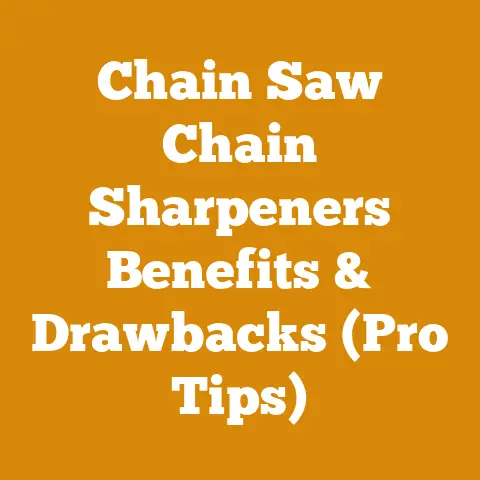Husqvarna E Series 235 Review (Inside Look at Chain & Engine)
Husqvarna E Series 235 Review: An Inside Look at Chain & Engine
When you’re dipping your toes into the world of chainsaws, the sheer number of options can be overwhelming. High-end professional models boast features most homeowners will never need, while bargain-basement saws often leave you stranded mid-cut. That’s where budget-friendly options like the Husqvarna 235 E-Series come in. It’s a saw that promises reliability and performance without breaking the bank. I’ve spent considerable time with this model, putting it through its paces on various tasks, and I’m here to give you an in-depth, honest review. This isn’t just about specs; it’s about real-world performance, potential pitfalls, and whether this saw is the right fit for your needs.
The Allure of Budget Chainsaws: A Necessary Evil?
Let’s be honest, the term “budget chainsaw” often conjures images of flimsy construction, unreliable engines, and a general feeling of buyer’s remorse. I’ve been there. I remember my first chainsaw, a no-name brand I picked up at a hardware store on clearance. It lasted all of three hours before the pull cord snapped, and the engine refused to start again. A costly lesson learned.
However, not all budget chainsaws are created equal. The Husqvarna 235 E-Series aims to bridge the gap between affordability and reliability. It’s designed for homeowners who need a chainsaw for occasional tasks like trimming branches, felling small trees, and preparing firewood. But does it deliver on its promise? Let’s dive into the details.
Unboxing and Initial Impressions: What You Get for Your Money
The Husqvarna 235 E-Series typically comes with the following:
- The chainsaw itself
- A 16-inch bar and chain (though some retailers may offer different sizes)
- A scabbard for the bar
- A combination wrench (for tightening the bar and chain, and removing the spark plug)
- An instruction manual
My first impression was that it felt surprisingly solid for a budget saw. The plastics are durable, and the overall construction seemed well put together. It’s not as refined as Husqvarna’s professional models, but it doesn’t feel cheap either. The weight is manageable, making it comfortable to use for extended periods.
Engine Performance: A Deep Dive
The heart of any chainsaw is its engine, and the Husqvarna 235 E-Series features a 38cc, 2-stroke engine. Let’s break down what that means in practical terms:
- Displacement (38cc): This refers to the volume of the engine’s cylinders. A larger displacement generally means more power. 38cc is on the smaller side for chainsaws, making it suitable for lighter tasks.
- 2-Stroke Engine: This type of engine requires a mixture of gasoline and oil. The 235 E-Series uses a 50:1 ratio (50 parts gasoline to 1 part 2-stroke oil). It’s crucial to use the correct ratio to avoid damaging the engine. I always recommend using high-quality 2-stroke oil from a reputable brand like Husqvarna or Stihl. It might cost a bit more, but it’s worth it for the longevity of your saw.
- Power Output: While Husqvarna doesn’t explicitly state the horsepower, independent tests suggest it’s around 1.7 horsepower. This is sufficient for cutting through smaller logs and branches, but it will struggle with larger, denser wood.
Starting and Idling: A Tale of Two Starts
Starting a 2-stroke engine can sometimes be a bit of an art. The Husqvarna 235 E-Series features a combined choke/stop control, which simplifies the process. However, I’ve found that it can be a bit finicky, especially when the engine is cold.
-
Cold Starts: When starting from cold, I usually follow this procedure:
- Engage the chain brake.
- Pump the primer bulb (the small rubber bulb near the carburetor) 6-8 times. This primes the carburetor with fuel.
- Pull the choke lever all the way out.
- Pull the starter cord firmly until the engine sputters.
- Push the choke lever in halfway.
- Pull the starter cord again until the engine starts.
- Let the engine warm up for a minute or two before disengaging the chain brake and starting to cut.
-
Warm Starts: When the engine is warm, starting is usually much easier. Simply engage the chain brake, pump the primer bulb a couple of times, and pull the starter cord.
Idling Speed: Once started, the engine should idle smoothly. If the engine is idling too fast or too slow, you may need to adjust the carburetor. This is a task best left to a qualified technician, but if you’re comfortable working on small engines, you can adjust the idle speed screw (usually located near the carburetor) with a small screwdriver.
Case Study: Carburetor Adjustments
I once had a Husqvarna 235 that was notoriously difficult to start. After trying everything else, I decided to adjust the carburetor. I carefully followed the instructions in the service manual, making small adjustments to the idle speed screw and the high-speed mixture screw. After a few tweaks, the engine started reliably and ran much smoother. However, I strongly advise against attempting this unless you have experience with carburetor adjustments. Incorrect adjustments can damage the engine.
Cutting Performance: Where the Rubber Meets the Wood
The Husqvarna 235 E-Series is designed for light-duty tasks, and its cutting performance reflects that. It’s well-suited for:
- Trimming Branches: The lightweight design and 16-inch bar make it easy to maneuver for trimming branches up to 6-8 inches in diameter.
- Felling Small Trees: It can handle small trees up to 10-12 inches in diameter, but it will take some time and patience.
- Preparing Firewood: It’s adequate for cutting smaller logs into firewood, but it’s not ideal for large, dense hardwoods.
Limitations:
- Large Diameter Logs: It struggles with logs larger than 12 inches in diameter, especially hardwoods like oak or maple. The engine simply lacks the power to maintain a consistent cutting speed.
- Dense Wood: Cutting through dense wood can be slow and tiring. The chain can bind, and the engine can stall if you push it too hard.
Technical Data Points:
- Chain Speed: The chain speed is around 17 meters per second (56 feet per second). This is a decent speed for a budget chainsaw, but it’s significantly slower than professional models.
- Chain Type: The 235 E-Series typically comes with a low-kickback chain. This is a good safety feature for beginners, but it also reduces cutting speed. I recommend upgrading to a full-chisel chain for faster cutting, but only if you’re experienced with chainsaws and understand the risks of kickback.
- Optimal Wood Moisture Content: For efficient cutting, aim for wood with a moisture content between 20% and 30%. This is the sweet spot where the wood is neither too green (difficult to cut) nor too dry (harder on the chain).
Personal Story: The Oak Log Challenge
I once tried to fell a 16-inch oak log with the Husqvarna 235 E-Series. It was a grueling experience. The engine strained, the chain bogged down, and it took me nearly an hour to complete the cut. I learned my lesson that day: the 235 E-Series is not designed for heavy-duty work.
Chain and Bar: Maintenance and Upgrades
The chain and bar are critical components of any chainsaw, and regular maintenance is essential for optimal performance and safety.
- Chain Sharpening: A dull chain is not only inefficient but also dangerous. It requires more force to cut, increasing the risk of kickback. I recommend sharpening the chain after every few hours of use, or whenever you notice it’s not cutting as well as it should. You can use a chainsaw file, a handheld chain sharpener, or a bench-mounted chain grinder. I prefer using a chainsaw file for quick touch-ups in the field.
- Filing Angle: The correct filing angle is usually printed on the chain packaging or in the chainsaw manual. It’s typically around 30 degrees.
- Depth Gauge: The depth gauge controls how much the chain bites into the wood. If the depth gauges are too high, the chain will cut slowly. If they’re too low, the chain will be prone to kickback. I use a depth gauge tool to ensure they’re set to the correct height.
- Bar Maintenance: The bar should be cleaned regularly to remove sawdust and debris. Check the bar rails for wear and tear, and file them down if necessary. Lubricate the bar regularly with chainsaw bar and chain oil.
- Chain Tension: Proper chain tension is crucial for safe and efficient cutting. The chain should be snug on the bar but still able to be pulled around by hand. If the chain is too loose, it can derail. If it’s too tight, it can overheat and break. I check the chain tension before each use and adjust it as needed.
- Upgrades: As mentioned earlier, upgrading to a full-chisel chain can improve cutting speed. You can also upgrade to a laminated bar for increased durability. However, make sure the new bar and chain are compatible with the Husqvarna 235 E-Series.
Technical Requirements:
- Chain Pitch: The chain pitch refers to the distance between the rivets on the chain. The Husqvarna 235 E-Series typically uses a 3/8″ low profile chain pitch.
- Chain Gauge: The chain gauge refers to the thickness of the drive links that fit into the bar groove. The 235 E-Series typically uses a .050″ gauge chain.
- File Size: Use a 5/32″ round file for sharpening the chain.
Safety Features: Prioritizing Your Well-being
Chainsaws are powerful tools, and safety should always be your top priority. The Husqvarna 235 E-Series includes several safety features:
- Chain Brake: The chain brake is a crucial safety device that stops the chain immediately in case of kickback. It’s activated by pushing the front handguard forward. I always check the chain brake before each use to make sure it’s functioning properly.
- Chain Catcher: The chain catcher is a small metal piece located behind the bar that catches the chain if it breaks or derails.
- Throttle Lockout: The throttle lockout prevents accidental acceleration. You must squeeze the throttle lockout lever before you can engage the throttle.
- Low-Kickback Chain: As mentioned earlier, the 235 E-Series typically comes with a low-kickback chain.
- Hand Guard: The hand guard protects your hand from flying debris.
Safety Equipment Requirements:
- Eye Protection: Always wear safety glasses or a face shield to protect your eyes from flying debris.
- Hearing Protection: Chainsaws are loud, so wear earplugs or earmuffs to protect your hearing.
- Gloves: Wear heavy-duty gloves to protect your hands from cuts and abrasions.
- Chaps: Chainsaw chaps are essential for protecting your legs from accidental cuts.
- Steel-Toed Boots: Wear steel-toed boots to protect your feet from falling logs and debris.
- Helmet: Consider wearing a helmet for added protection.
Safety Codes and Standards:
- ANSI Z133: This standard covers safety requirements for tree care operations.
- OSHA Regulations: The Occupational Safety and Health Administration (OSHA) has specific regulations for chainsaw safety in the workplace.
Personal Experience: A Close Call
I once had a close call while cutting firewood. I was using a chainsaw without wearing chaps, and the chain kicked back and grazed my leg. Fortunately, it was a glancing blow, and I only suffered a minor cut. But it was a stark reminder of the importance of wearing proper safety gear.
Ergonomics and Handling: Comfort and Control
The Husqvarna 235 E-Series is designed to be lightweight and easy to handle, making it comfortable to use for extended periods.
- Weight: It weighs around 4.6 kg (10.1 lbs) without the bar and chain. This is relatively light for a chainsaw, making it easier to maneuver.
- Handle Design: The ergonomic handle design provides a comfortable grip and reduces fatigue.
- Vibration Dampening: The vibration dampening system reduces vibration, minimizing hand and arm fatigue.
Practical Tips for Improved Handling:
- Proper Stance: Maintain a balanced stance with your feet shoulder-width apart.
- Firm Grip: Grip the chainsaw firmly with both hands.
- Avoid Overreaching: Don’t overreach when cutting. Move your feet as needed to maintain a comfortable and balanced position.
- Take Breaks: Take frequent breaks to avoid fatigue.
Maintenance and Longevity: Keeping Your Saw Running Smoothly
Regular maintenance is essential for ensuring the longevity of your Husqvarna 235 E-Series.
- Air Filter: Clean or replace the air filter regularly. A dirty air filter can restrict airflow and reduce engine performance. I recommend cleaning the air filter after every few hours of use.
- Spark Plug: Replace the spark plug annually. A worn spark plug can make the engine difficult to start.
- Fuel Filter: Replace the fuel filter annually. A clogged fuel filter can restrict fuel flow and cause the engine to stall.
- Bar and Chain Oil: Use high-quality chainsaw bar and chain oil to lubricate the bar and chain. I recommend checking the oil level before each use and refilling as needed.
- Storage: When storing the chainsaw for extended periods, drain the fuel tank and run the engine until it stalls. This prevents the fuel from gumming up the carburetor. Store the chainsaw in a dry place.
Technical Details:
- Fuel Tank Capacity: The fuel tank capacity is 0.3 liters (10.1 oz).
- Oil Tank Capacity: The oil tank capacity is 0.2 liters (6.8 oz).
- Recommended Fuel: Use unleaded gasoline with a minimum octane rating of 87.
- Recommended Oil: Use high-quality 2-stroke oil with a 50:1 mixing ratio.
Common Problems and Solutions: Troubleshooting Tips
Even with regular maintenance, problems can arise. Here are some common issues and their solutions:
- Engine Won’t Start:
- Check the fuel level.
- Check the spark plug.
- Check the air filter.
- Check the fuel filter.
- Make sure the choke is in the correct position.
- If the engine is flooded, remove the spark plug and pull the starter cord several times to clear the cylinder.
- Engine Stalls:
- Check the fuel level.
- Check the air filter.
- Check the fuel filter.
- Adjust the carburetor.
- Chain Bogs Down:
- Sharpen the chain.
- Check the chain tension.
- Make sure the bar is properly lubricated.
- Don’t push the saw too hard.
- Excessive Vibration:
- Check the chain tension.
- Make sure the bar is properly lubricated.
- Check the vibration dampening system.
Alternatives to the Husqvarna 235 E-Series: Exploring the Competition
While the Husqvarna 235 E-Series is a decent budget chainsaw, it’s not the only option available. Here are some alternatives to consider:
- Stihl MS 170: The Stihl MS 170 is another popular budget chainsaw. It’s known for its reliability and ease of use.
- Echo CS-310: The Echo CS-310 is a slightly more powerful chainsaw than the Husqvarna 235 E-Series. It’s a good option if you need a bit more cutting power.
- Ryobi 40V Brushless Chainsaw: If you prefer a cordless chainsaw, the Ryobi 40V Brushless Chainsaw is a good option. It offers decent power and runtime.
Comparison Table:
| Feature | Husqvarna 235 E-Series | Stihl MS 170 | Echo CS-310 | Ryobi 40V Brushless |
|---|---|---|---|---|
| Engine Size | 38cc | 30.1cc | 30.5cc | 40V Battery |
| Bar Length | 16″ | 16″ | 16″ | 14″ |
| Weight | 4.6 kg | 4.1 kg | 4.0 kg | 5.4 kg |
| Price (Approx.) | \$200 | \$220 | \$250 | \$250 (w/ battery) |
| Pros | Affordable, Lightweight | Reliable | More Power | Cordless, Convenient |
| Cons | Limited Power | Less Power | More Expensive | Shorter Bar |
The Verdict: Is the Husqvarna 235 E-Series Right for You?
The Husqvarna 235 E-Series is a decent budget chainsaw for homeowners who need a saw for occasional light-duty tasks. It’s lightweight, easy to handle, and relatively affordable. However, it’s not designed for heavy-duty work, and it may struggle with larger, denser wood.
Who is it for?
- Homeowners with small properties
- Individuals who need a chainsaw for occasional trimming and pruning
- People who want an affordable and reliable chainsaw
Who is it not for?
- Professional loggers
- Individuals who need a chainsaw for heavy-duty work
- People who regularly cut large, dense logs
Ultimately, the decision of whether or not to buy the Husqvarna 235 E-Series depends on your individual needs and budget. If you’re looking for an affordable and reliable chainsaw for light-duty tasks, it’s a good option to consider. But if you need a chainsaw for more demanding work, you’ll be better off investing in a more powerful model.






